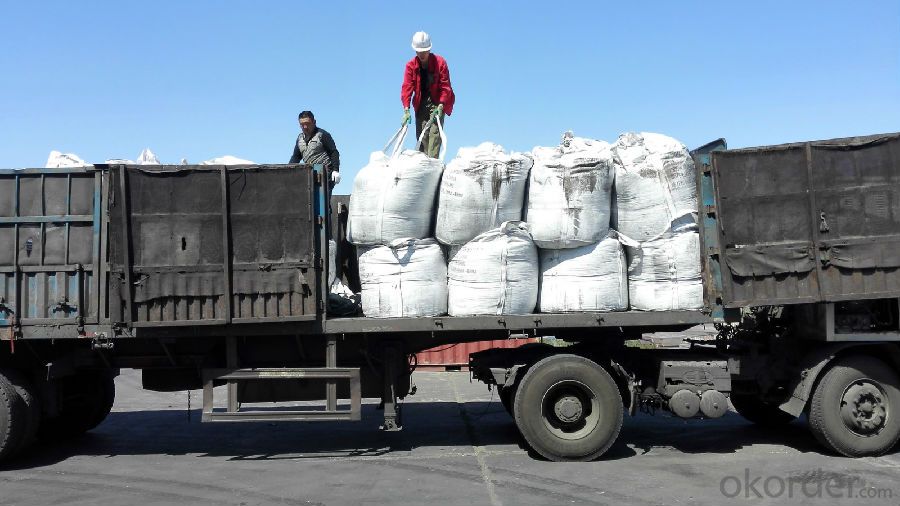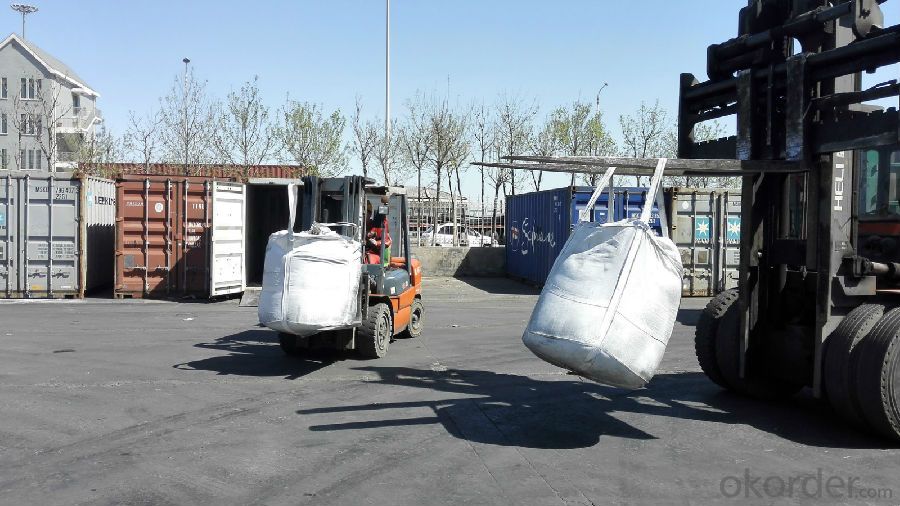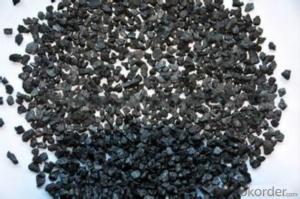S0.5% GCA with Ash 4% for steel plant made in China
- Loading Port:
- Tianjin
- Payment Terms:
- TT OR LC
- Min Order Qty:
- 21 m.t.
- Supply Capability:
- 1010 m.t./month
OKorder Service Pledge
OKorder Financial Service
You Might Also Like
Introduction:
Calcined anthracite can be called carbon additive, carbon raiser, recarburizer, injection coke, charging coke, gas calcined anthracite.It is playing more and more important role in the industry
Best quality Anthracite as raw materials through high temperature calcined at over 2000℃ by the DC electric calciner with results in eliminating the moisture and volatile matter from Anthracite efficiently, improving the density and the electric conductivity and strengthening the mechanical strength and anti-oxidation. It has good characteristics with low ash, low resistivity, low sulphur, high carbon and high density. It is the best material for high quality carbon products. It is used as carbon additive in steel industry or fuel.
Features:
G-High Calcined Anthracite is produced when Anthracite is calcined under the temperature of 1240°C in vertical shaft furnaces. G-High Calcined Anthracite is mainly used in electric steel ovens, water filtering, rust removal in shipbuilding and production of carbon material. We are professional in quality control and customer service
Specifications:
F.C.% | 95MIN | 94MIN | 93MIN | 92MIN | 90MIN | 85MIN | 84MIN |
ASH % | 4MAX | 5MAX | 6 MAX | 6.5MAX | 8.5MAX | 12MAX | 13MAX |
V.M.% | 1 MAX | 1MAX | 1.0MAX | 1.5MAX | 1.5MAX | 3 MAX | 3 MAX |
SULFUR % | 0.3MAX | 0.3MAX | 0.3MAX | 0.35MAX | 0.35MAX | 0.5MAX | 0.5MAX |
MOISTURE % | 0.5MAX | 0.5MAX | 0.5MAX | 0.5MAX | 0.5MAX | 1MAX | 1MAX |
Pictures




FAQ:
Packing:
(1). Waterproof jumbo bags: 800kgs~1100kgs/ bag according to different grain sizes;
(2). Waterproof PP woven bags / Paper bags: 5kg / 7.5kg / 12.5kg / 20kg / 25kg / 30kg / 50kg small bags;
(3). Small bags into jumbo bags: waterproof PP woven bags / paper bags in 800kg ~1100kg jumbo bags.
Payment terms
20% down payment and 80% against copy of B/L.
Workable LC at sight,
Any questions, pls kindly contact us
- Q:How does carbon contribute to the flavor of food?
- There are multiple ways in which carbon, found in charcoal or charred substances, can enhance the flavor of food. Firstly, when food is cooked over charcoal, the carbon gives it a smoky taste and aroma, which enhances the overall flavor. This smokiness is particularly desirable in dishes such as barbecued meats, vegetables, and certain cheeses, as it adds a unique and enjoyable element to the taste. Additionally, carbon can serve as a natural filter, absorbing and eliminating impurities from food and drinks. This filtration process helps to get rid of unpleasant smells and flavors, resulting in a cleaner and more refined taste. For instance, activated carbon is often used in the production of alcoholic beverages like whiskey or vodka to remove impurities and create a smoother and more flavorful drink. Moreover, carbon can contribute to the development of desirable texture and color in certain foods. When sugar or other carbohydrates are heated, they undergo caramelization, a process in which the sugars react with heat to form a complex mixture of carbon compounds. This caramelization process creates rich, golden-brown hues and a unique depth of flavor, enhancing the overall taste experience. Lastly, carbon plays a crucial role in the fermentation process, which is essential in producing various types of food and drinks. During fermentation, microorganisms consume sugars and release carbon dioxide, which contributes to the texture, flavor, and carbonation of the final product. This is particularly evident in bread, beer, wine, and other fermented foods, where the presence of carbon dioxide adds lightness, complexity, and effervescence to the flavor. To summarize, carbon enhances the flavor of food through its ability to impart smokiness, act as a natural filter, facilitate caramelization, and participate in fermentation processes. Its presence in different forms enhances the taste, texture, and overall enjoyment of a wide range of food and drinks.
- Q:When will amines be fertilized?
- Avoid high temperature applications. The temperature is below 20 DEG C when ammonium bicarbonate is relatively stable, high temperature or moisture in the product exceeds a certain standard, is easy to be decomposed into ammonia and carbon dioxide emissions in the air, causing loss of nitrogen fertilizer. According to the test results show that the winter crops better than urea and ammonium carbonate. Because the temperature is low in winter, the process of urea conversion is long, but the ammonium carbonate can be directly absorbed without conversion. It is beneficial to the early growth and fast growth of winter crops. In addition, when applied to the soil ammonium bicarbonate, ammonium ion dissociation can be directly by soil colloid adsorption, and urea to winter crop soil, urea was dissolved in the soil solution in the molecular state, but not by soil colloid adsorption, it is more likely to cause the loss of nutrientsThe use of ammonium bicarbonate does not mix with alkaline fertilizers, which can lead to loss of nitrogen nutrients, resulting in low fertilizer efficiency. Using ammonium hydrogen carbonate friends should know that not with urea and ammonium hydrogen carbonate mixed fertilizer, ammonium bicarbonate if mixed with urea, urea conversion rate will not only extend, and will accelerate the volatilization of urea.Ammonium bicarbonate extremely volatile, so to avoid the ground using ammonium bicarbonate, ammonium bicarbonate has strong corrosion on leaf blade, easy to burn, can not be used as a foliar spray. There is one thing to note is that if the soil drought, even deep application coverage, can not be dissolved in ammonium bicarbonate, better soil moisture using ammonium bicarbonate, can reduce the volatilization loss, improve efficiency
- Q:There are several allotropes of carbon
- Allotrope of carbon: diamond, graphite, carbon 60 (fullerene), amorphous carbon (charcoal, coke, activated carbon, etc.)
- Q:How does carbon affect the quality of drinking water?
- Carbon can affect the quality of drinking water through two main mechanisms: activated carbon filtration and carbon dioxide (CO2) absorption. Activated carbon filtration is commonly used in water treatment processes to remove organic contaminants, chemicals, and odors, improving the taste and odor of drinking water. On the other hand, excessive dissolved carbon dioxide in water can make it acidic and affect the pH level, potentially making it corrosive and altering the taste. However, carbon itself is not harmful to human health and can be beneficial in certain forms, such as in the form of activated carbon filters.
- Q:What are the applications of graphite in industry?
- Graphite has various applications in the industry due to its unique properties. It is commonly used as a lubricant in machinery and equipment due to its low friction coefficient. Graphite is also used as an electrode material in batteries, as it can store and release electrical energy efficiently. Additionally, it is used in the production of crucibles, refractory materials, and foundry molds due to its high heat resistance. Graphite is also utilized in the manufacturing of steel and other metals, as it acts as a carbon additive to improve their strength and durability.
- Q:How are carbon compounds classified?
- Carbon compounds are classified based on their structural arrangement, functional groups, and the type of bonds they form with other elements.
- Q:What is the role of carbon in photosynthesis?
- The essential role of carbon in photosynthesis cannot be overstated. Carbon dioxide, a primary reactant in the photosynthesis process, combines with water and sunlight energy to produce glucose, which serves as the main source of energy for plant growth and development. To enter the leaf, carbon dioxide utilizes tiny pores known as stomata, diffusing into the chloroplasts where photosynthesis occurs. Within the chloroplasts, carbon dioxide interacts with water, sunlight, and chlorophyll, resulting in a series of chemical reactions called the Calvin cycle or dark reactions. During this cycle, glucose is synthesized and stored as a vital energy source for plants. The carbon atoms in carbon dioxide act as the foundation for glucose and other organic compounds produced during photosynthesis. Through a complex sequence of enzymatic reactions, carbon dioxide is transformed into carbohydrates, lipids, proteins, and nucleic acids, all of which are necessary for plant growth and survival. Moreover, photosynthesis plays a significant role in the global carbon cycle, not only producing glucose but also regulating the levels of carbon dioxide in the atmosphere and releasing oxygen as a byproduct. This process helps mitigate climate change and maintains the necessary balance of oxygen for all living organisms. In essence, carbon's role in photosynthesis is pivotal, serving as the raw material for glucose synthesis and other organic compounds. Through this process, plants convert carbon dioxide into energy-rich molecules, contributing to their survival, growth, and the overall equilibrium of carbon in the Earth's atmosphere.
- Q:What is carbon dioxide?
- Carbon dioxide (CO2) is a colorless and odorless gas composed of one carbon atom bonded to two oxygen atoms. It is naturally present in the Earth's atmosphere and is also produced by human activities such as burning fossil fuels and deforestation. Carbon dioxide plays a crucial role in the Earth's carbon cycle and is a greenhouse gas, contributing to global warming and climate change.
- Q:What is the carbon emission of the air conditioner?
- Summer less air-conditioning 1 hours, it will reduce carbon emissions of 0.621kg
- Q:Carbon fiber refractory?
- 3, pre oxidized carbon fiber cloth, can withstand 200--300 degrees of high temperature
1. Manufacturer Overview |
|
|---|---|
| Location | |
| Year Established | |
| Annual Output Value | |
| Main Markets | |
| Company Certifications | |
2. Manufacturer Certificates |
|
|---|---|
| a) Certification Name | |
| Range | |
| Reference | |
| Validity Period | |
3. Manufacturer Capability |
|
|---|---|
| a)Trade Capacity | |
| Nearest Port | |
| Export Percentage | |
| No.of Employees in Trade Department | |
| Language Spoken: | |
| b)Factory Information | |
| Factory Size: | |
| No. of Production Lines | |
| Contract Manufacturing | |
| Product Price Range | |
Send your message to us
S0.5% GCA with Ash 4% for steel plant made in China
- Loading Port:
- Tianjin
- Payment Terms:
- TT OR LC
- Min Order Qty:
- 21 m.t.
- Supply Capability:
- 1010 m.t./month
OKorder Service Pledge
OKorder Financial Service
Similar products
New products
Hot products




























